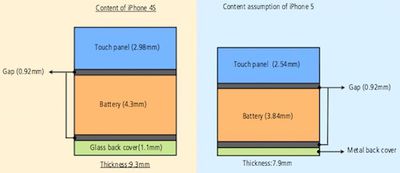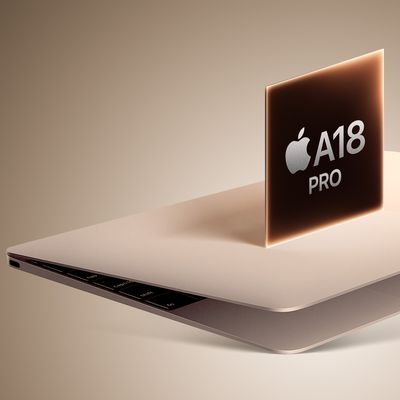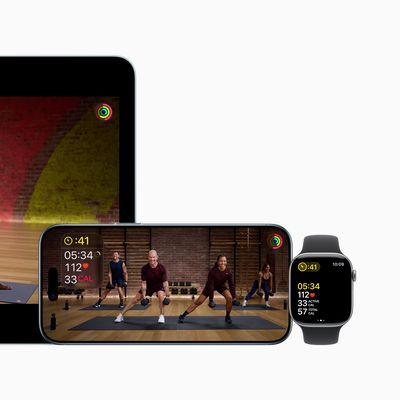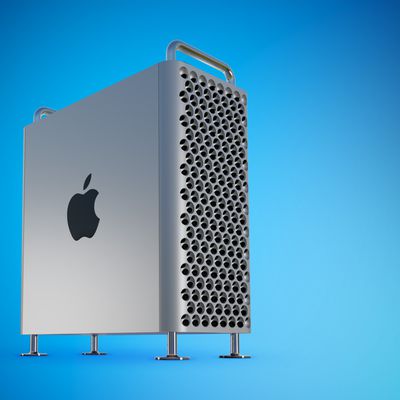In-Cell Touch Technology Could Help Apple Reduce Next iPhone's Thickness by 15%
Following last week's rumor that Apple is looking to adopt thinner in-cell touch technology for the display of the next-generation iPhone, analyst Ming-Chi Kuo, who recently took on a new position with KGI Securities, has issued a report looking at how that change could help Apple reduce the thickness of the iPhone from the current 9.3 mm of the iPhone 4S to under 8 mm. The move would help Apple to compete against its Android-based challengers, which have continued to see reductions in their thickness over time.
Since Apple’s smartphone competitors have generally slimmed down their high-end offerings to 7-8mm, Apple needs to make a leap forward from 4S’ 9.3mm thickness. We believe Apple will aim at 8mm or below (at least 1.4mm slimmer) for iPhone 5, in a bid to ensure brisk sales through 2014, while peers will also continue to introduce increasingly slim models next year.
As such, all iPhone 4S components that account for thickness must be slimmer, specifically, touch panel, battery and casing. Moreover, a marginal amount of space is required between the three parts for the sakes of assembly tolerance and thermal expansion of components.
Kuo calculates that shifting to in-cell touch technology in the next iPhone will yield Apple just shy of 0.5 mm in terms of a reduction in thickness. Kuo envisions a similar reduction coming from the battery, which he predicts Apple will be able to broaden somewhat inside the casing, allowing for a roughly 10% reduction in battery thickness.
A final 0.5 mm reduction in thickness could come from the use of a metal back case, which could come in at half the thickness of the glass back used in the current iPhone. Altogether, Apple could shave 1.4 mm from the iPhone's thickness to bring the next-generation model in at just 7.9 mm thick.

In yet another argument for the adoption of in-cell touch technology for the display in the next-generation iPhone, Kuo notes that display production would be greatly simplified, with fewer steps in the manufacturing process and fewer vendors being involved resulting in an estimated reduction in production time from 12-16 days to just 3-5 days.
While the initial yield on in-cell touch displays is currently lower than for glass-on-glass manufacturing techniques such as those used for the iPhone 4S, that deficiency can be compensated for by re-bonding in-cell panels and cover glass units with the optically clear resin (OCR) used in the bonding process. The optically clear adhesive (OCA) used in the current manufacturing process can not be re-bonded if the initial bonding fails.
Popular Stories
Apple is not expected to release a standard iPhone 18 model this year, according to a growing number of reports that suggest the company is planning a significant change to its long-standing annual iPhone launch cycle.
Despite the immense success of the iPhone 17 in 2025, the iPhone 18 is not expected to arrive until the spring of 2027, leaving the iPhone 17 in the lineup as the latest...
Language learning app Duolingo has apparently been using the iPhone's Live Activity feature to display ads on the Lock Screen and the Dynamic Island, which violates Apple's design guidelines.
According to multiple reports on Reddit, the Duolingo app has been displaying an ad for a "Super offer," which is Duolingo's paid subscription option.
Apple's guidelines for Live Activity state that...
The company behind the BlackBerry-like Clicks Keyboard accessory for the iPhone today unveiled a new Android 16 smartphone called the Clicks Communicator.
The purpose-built device is designed to be used as a second phone alongside your iPhone, with the intended focus being communication over content consumption. It runs a custom Android launcher that offers a curated selection of messaging...
Apple plans to introduce a 12.9-inch MacBook in spring 2026, according to TrendForce.
In a press release this week, the Taiwanese research firm said this MacBook will be aimed at the entry-level to mid-range market, with "competitive pricing."
TrendForce did not share any further details about this MacBook, but the information that it shared lines up with several rumors about a more...
Apple today announced a number of updates to Apple Fitness+ and activity with the Apple Watch.
The key announcements include:
New Year limited-edition award: Users can win the award by closing all three Activity Rings for seven days in a row in January.
"Quit Quitting" Strava challenge: Available in Strava throughout January, users who log 12 workouts anytime in the month will win an ...
Apple is planning to release a low-cost MacBook in 2026, which will apparently compete with more affordable Chromebooks and Windows PCs. Apple's most affordable Mac right now is the $999 MacBook Air, and the upcoming low-cost MacBook is expected to be cheaper. Here's what we know about the low-cost MacBook so far.
Size
Rumors suggest the low-cost MacBook will have a display that's around 13 ...
Apple hasn't updated the Mac Pro since 2023, and according to recent rumors, there's no update coming in the near future. In fact, Apple might be finished with the Mac Pro.
Bloomberg recently said that the Mac Pro is "on the back burner" and has been "largely written off" by Apple. Apple apparently views the more compact Mac Studio as the ideal high-end pro-level desktop, and it has almost...























